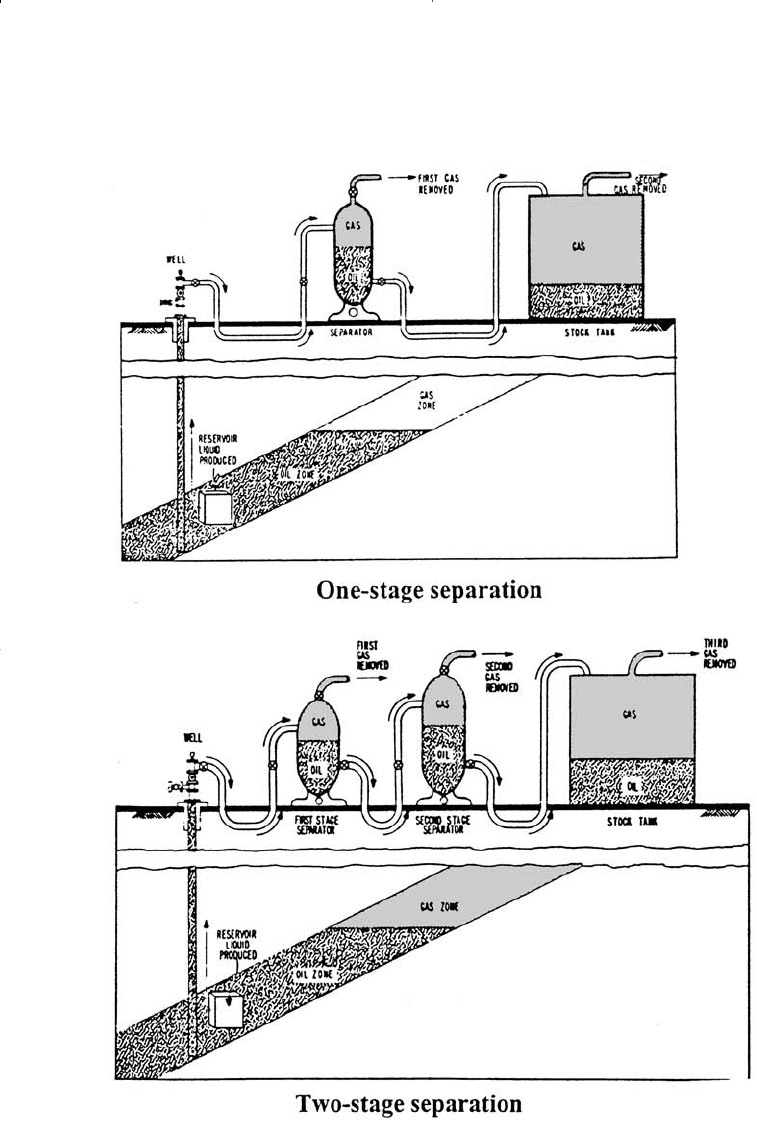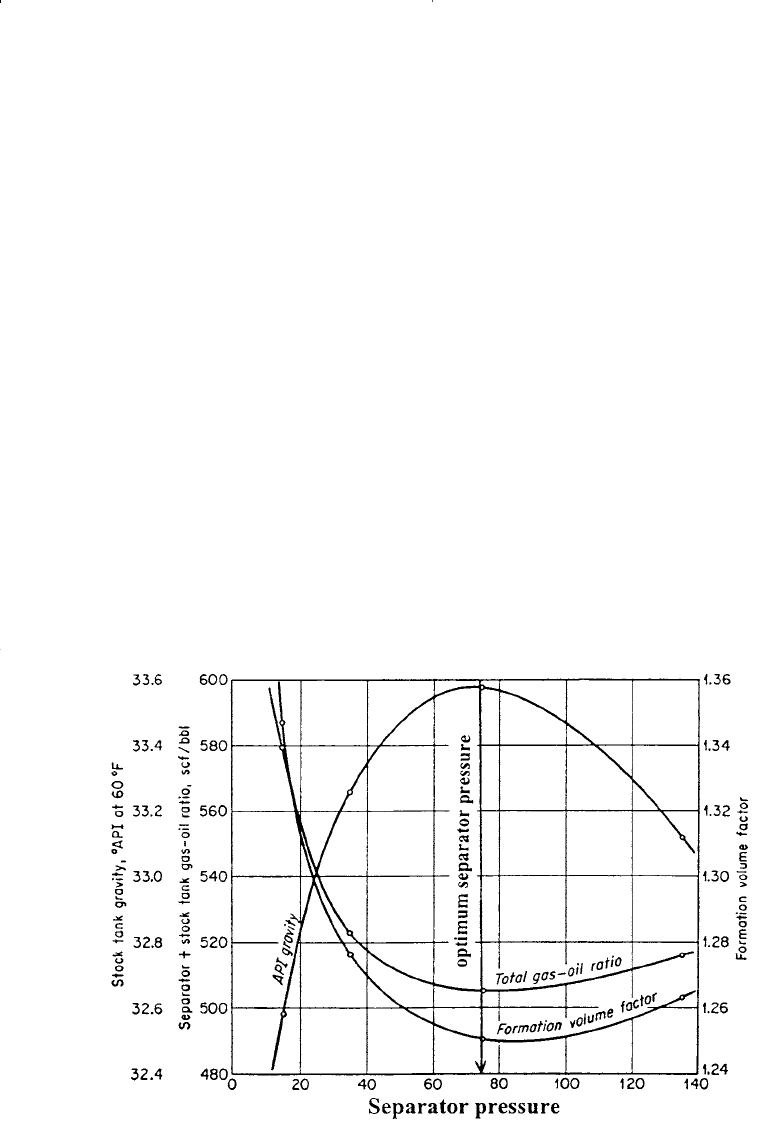Tarek Ahmed. Reservoir engineering handbook
Подождите немного. Документ загружается.


Step 5. Employing the iterative procedure outlined previously and using
the Whitson and Torp equilibrium ratio correlation gives:
K
i
at K
i
at K
i
at
3924 3950 4,329
Component z
i
psia z
i
K
i
psia z
i
K
i
psia z
i
K
i
C
1
0.42 2.257 0.9479 2.242 0.9416 2.0430 0.8581
C
2
0.05 1.241 0.06205 2.137 0.0619 1.1910 0.0596
C
3
0.05 0.790 0.0395 0.7903 0.0395 0.793 0.0397
i – C
4
0.03 0.5774 0.0173 0.5786 0.0174 0.5977 0.0179
n – C
4
0.02 0.521 0.0104 0.5221 0.0104 0.5445 0.0109
i – C
5
0.01 0.3884 0.0039 0.3902 0.0039 0.418 0.0042
n – C
5
0.01 0.3575 0.0036 0.3593 0.0036 0.3878 0.0039
C
6
0.01 0.2530 0.0025 0.2549 0.0025 0.2840 0.0028
C
7+
0.40 0.227 0.0091 0.0232 0.00928 0.032 0.0138
1.09625 1.09008 1.0099
The calculated bubble-point pressure is 4330 psia.
Separator Calculations
Produced reservoir fluids are complex mixtures of different physical
characteristics. As a well stream flows from the high-temperature, high-
pressure petroleum reservoir, it experiences pressure and temperature
reductions. Gases evolve from the liquids and the well stream changes in
character. The physical separation of these phases is by far the most com-
mon of all field-processing operations and one of the most critical. The
manner in which the hydrocarbon phases are separated at the surface
influences the stock-tank oil recovery. The principal means of surface
separation of gas and oil is the conventional stage separation.
Stage separation is a process in which gaseous and liquid hydrocarbons
are flashed (separated) into vapor and liquid phases by two or more sepa-
rators. These separators are usually operated in series at consecutively
lower pressures. Each condition of pressure and temperature at which
hydrocarbon phases are flashed is called a stage of separation. Examples
of one- and two-stage separation processes are shown in Figure 15-6. Tra-
ditionally, the stock-tank is normally considered a separate stage of sepa-
ration. Mechanically, there are two types of gas-oil separation: (1) differ-
ential separation and (2) flash or equilibrium separation.
1058 Reservoir Engineering Handbook
Reservoir Eng Hndbk Ch 15 2001-10-25 17:41 Page 1058

Figure 15-6. Schematic drawing of one- and two-stage separation processes.
(After Clark, 1951)
Vapor–Liquid Phase Equilibria 1059
Reservoir Eng Hndbk Ch 15 2001-10-25 17:41 Page 1059

To explain the various separation processes, it is convenient to define
the composition of a hydrocarbon mixture by three groups of components:
1. The very volatile components (“lights”), such as nitrogen, methane,
and ethane
2. The components of intermediate volatility (“intermediates”), such as
propane through hexane
3. The components of less volatility, or the “heavies,” such as heptane
and heavier components
In the differential separation, the liberated gas (which is composed
mainly of lighter components) is removed from contact with the oil as
the pressure on the oil is reduced. As pointed out by Clark (1960), when
the gas is separated in this manner, the maximum amount of heavy and
intermediate components will remain in the liquid, minimum shrinkage
of the oil will occur, and, therefore, greater stock-tank oil recovery will
occur. This is due to the fact that the gas liberated earlier at higher pres-
sures is not present at lower pressures to attract the intermediate and
heavy components and pull them into the gas phase.
In the flash (equilibrium) separation, the liberated gas remains in con-
tact with oil until its instantaneous removal at the final separation pres-
sure. A maximum proportion of intermediate and heavy components is
attracted into the gas phase by this process, and this results in a maxi-
mum oil shrinkage and, thus, a lower oil recovery.
In practice, the differential process is introduced first in field separa-
tion when gas or liquid is removed from the primary separator. In each
subsequent stage of separation, the liquid initially undergoes a flash lib-
eration followed by a differential process as actual separation occurs. As
the number of stages increases, the differential aspect of the overall sepa-
ration becomes greater.
The purpose of stage separation then is to reduce the pressure on the
produced oil in steps so that more stock-tank oil recovery will result.
Separator calculations are basically performed to determine:
• Optimum separation conditions: separator pressure and temperature
• Compositions of the separated gas and oil phases
• Oil formation volume factor
• Producing gas–oil ratio
• API gravity of the stock-tank oil
1060 Reservoir Engineering Handbook
Reservoir Eng Hndbk Ch 15 2001-10-25 17:41 Page 1060

Note that if the separator pressure is high, large amounts of light compo-
nents will remain in the liquid phase at the separator and be lost along with
other valuable components to the gas phase at the stock tank. On the other
hand, if the pressure is too low, large amounts of light components will be
separated from the liquid and they will attract substantial quantities of
intermediate and heavier components. An intermediate pressure, called
optimum separator pressure, should be selected to maximize the oil vol-
ume accumulation in the stock tank. This optimum pressure will also yield:
• A maximum stock-tank API gravity
• A minimum oil formation volume factor (i.e., less oil shrinkage)
• A minimum producing gas–oil ratio (gas solubility)
The concept of determining the optimum separator pressure by calcu-
lating the API gravity, B
o
, and R
s
is shown graphically in Figure 15-7.
The computational steps of the separator calculations are described
below in conjunction with Figure 15-8, which schematically shows a
bubble-point reservoir flowing into a surface separation unit consisting
of n stages operating at successively lower pressures.
Figure 15-7. Effect of separator pressure on API, B
o
, and GOR. (After Amyx, Bass,
and Whiting, 1960.)
Vapor–Liquid Phase Equilibria 1061
Reservoir Eng Hndbk Ch 15 2001-10-25 17:41 Page 1061

Figure 15-8. Schematic illustration of n separation stages.
Step 1. Calculate the volume of oil occupied by 1 lb-mol of crude at the
reservoir pressure and temperature. This volume, denoted V
o
, is
calculated by recalling and applying the equation that defines the
number of moles to give:
Solving for the oil volume gives:
where m = total weight of 1 lb-mol of crude oil, lb/mol
V
o
= volume of 1 lb-mol of crude oil at reservoir
conditions, ft
3
/mol
M
a
= apparent molecular weight
o
= density of the reservoir oil, lb/ft
3
V
M
o
a
o
=
(
)
ρ
15 - 37
n
m
M
V
M
a
oo
a
== =
ρ
1
1062 Reservoir Engineering Handbook
Reservoir Eng Hndbk Ch 15 2001-10-25 17:41 Page 1062

Step 2. Given the composition of the feed stream z
i
to the first separator
and the operating conditions of the separator, i.e., separator pres-
sure and temperature, calculate the equilibrium ratios of the
hydrocarbon mixture.
Step 3. Assuming a total of 1 mol of the feed entering the first separator
and using the above calculated equilibrium ratios, perform flash
calculations to obtain the compositions and quantities, in moles,
of the gas and the liquid leaving the first separator. Designating
these moles as (n
L
)
1
and (n
v
)
1
, the actual number of moles of the
gas and the liquid leaving the first separation stage are:
where [n
v1
]
a
= actual number of moles of vapor leaving the
first separator
[n
L1
]
a
= actual number of moles of liquid leaving the
first separator
Step 4. Using the composition of the liquid leaving the first separator as
the feed for the second separator, i.e., z
i
= x
i
, calculate the equi-
librium ratios of the hydrocarbon mixture at the prevailing pres-
sure and temperature of the separator.
Step 5. Based on 1 mol of the feed, perform flash calculations to deter-
mine the compositions and quantities of the gas and liquid leav-
ing the second separation stage. The actual number of moles of
the two phases are then calculated from:
where [n
v2
]
a
, [n
L2
]
a
= actual moles of gas and liquid leaving
separator 2
(n
v
)
2
, (n
L
)
2
= moles of gas and liquid as determined
from flash calculations
nnn nn
L
a
L
a
LLL21
212
1
[]
=
[]
(
)
=
(
)
(
)
(
)
nnn nn
v
a
L
a
vLv21
2
1
2
1
[]
=
[]
(
)
=
(
)
(
)
(
)
nnn n
L
a
LL1
11
1
[]
=
(
)
(
)
=
(
)
(
)
nnn n
v
a
vv1
11
1
[]
=
(
)
(
)
=
(
)
(
)
Vapor–Liquid Phase Equilibria 1063
Reservoir Eng Hndbk Ch 15 2001-10-25 17:41 Page 1063

Step 6. The previously outlined procedure is repeated for each separation
stage, including the stock-tank storage, and the calculated moles
and compositions are recorded. The total number of moles of gas
off all stages are then calculated as:
In a more compacted form, the above expression can be written:
where (n
v
)
t
= total moles of gas off all stages, lb-mol/mol of
feed
n = number of separation stages
Total moles of liquid remaining in the stock tank can also be calcu-
lated as:
or
where
(n
L
)
st
= number of moles of liquid remaining in the stock tank.
(n
L
)
i
= moles of liquid off ith stage.
Step 7. Calculate the volume, in scf, of all the liberated solution gas from:
where V
g
= total volume of the liberated solution gas scf/mol
of feed.
Step 8. Determine the volume of stock-tank oil occupied by (n
L
)
st
moles
of liquid from:
Vn
gv
t
=
(
)
(
)
379 4.
15 - 40
nn
L
st
L
i
i
n
(
)
=
(
)
(
)
=
∏
1
15 - 39
nnnn
L
st
LL Ln
(
)
=
12
...
nn n n
v
t
vv
i
L
j
j
i
i
n
(
)
=
(
)
+
(
)
(
)
(
)
=
−
=
∏
∑
1
1
1
2
15 - 38
nnnnnnnn
nn n
v
t
va
i
i
n
vLv LLv
LL
n
v
n
(
)
=
(
)
=
(
)
+
(
)
(
)
+
(
)
(
)
(
)
++
(
)
(
)
(
)
=
−
∑
1
1
1
2
12
3
11
K ...
1064 Reservoir Engineering Handbook
Reservoir Eng Hndbk Ch 15 2001-10-25 17:41 Page 1064

where (V
o
)
st
= volume of stock-tank oil, ft
3
/mol of feed
(M
a
)
st
= apparent molecular weight of the stock-tank oil
(
o
)
st
= density of the stock-tank oil, lb/ft
3
Step 9. Calculate the specific gravity and the API gravity of the stock-
tank oil by applying these expressions:
Step 10. Calculate the total gas–oil ratio (or gas solubility R
s
) :
where GOR = gas–oil ratio, scf/STB.
Step 11. Calculate the oil formation volume factor from the relationship:
Combining Equations 15-37 and 15-41 with the above expression
gives:
where B
o
= oil formation volume factor, bbl/STB
M
a
= apparent molecular weight of the feed
(M
a
)
st
= apparent molecular weight of the stock-tank oil
o
= density of crude oil at reservoir conditions, lb/ft
3
B
M
nM
o
ao
st
oL
st
a
st
=
(
)
(
)
(
)
ρ
ρ
B
V
V
o
o
o
st
=
(
)
GOR
n
nM
v
t
o
st
L
st
st
=
(
)
(
)
(
)
(
)
(
)
2 130 331,. ρ
15 - 42
GOR
V
V
n
nM
g
o
st
v
t
L
st
st
o
st
=
(
)
=
(
)
(
)
(
)
(
)
(
)
(
)
5 615
5 615 379 4
.
..
ρ
°= −API
o
141 5
131 5
.
.
γ
γ
ρ
o
o
st
=
(
)
62 4.
V
nM
o
st
L
st
a
st
o
st
(
)
=
(
)
(
)
(
)
−
(
)
ρ
15 41
Vapor–Liquid Phase Equilibria 1065
Reservoir Eng Hndbk Ch 15 2001-10-25 17:41 Page 1065

The separator pressure can be optimized by calculating the API gravity,
GOR, and B
o
in the manner outlined above at different assumed pres-
sures. The optimum pressure corresponds to a maximum in the API grav-
ity and a minimum in gas–oil ratio and oil formation volume factor.
Example 15-6
A crude oil, with the composition given below, exists at its bubble-
point pressure of 1708.7 psia and at a temperature of 131
o
F. The crude oil
is flashed through two-stage and stock-tank separation facilities. The
operating conditions of the three separators are:
Separator Pressure, psia Temperature, °F
1 400 72
2 350 72
Stock tank 14.7 60
The composition of the crude oil is given below:
Component z
i
CO
2
0.0008
N
2
0.0164
C
1
0.2840
C
2
0.0716
C
3
0.1048
i – C
4
0.0420
n – C
4
0.0420
i – C
5
0.0191
n – C
5
0.0191
C
6
0.0405
C
7+
0.3597
The molecular weight and specific gravity of C
7+
are 252 and 0.8429.
Calculate B
o
, R
S
, stock-tank density, and the API gravity of the hydrocar-
bon system.
Solution
Step 1. Calculate the apparent molecular weight of the crude oil to give
M
a
= 113.5102.
Step 2. Calculate the density of the bubble-point crude oil by using the
Standing and Katz correlation to yield
o
= 44.794 lb/ft
3
.
1066 Reservoir Engineering Handbook
Reservoir Eng Hndbk Ch 15 2001-10-25 17:41 Page 1066

Step 3. Flash the original composition through the first separator by gen-
erating the equilibrium ratios by using the Standing correlation
(Equation 15-20) to give:
Component z
i
K
i
x
i
y
i
CO
2
0.0008 3.509 0.0005 0.0018
N
2
0.0164 39.90 0.0014 0.0552
C
1
0.2840 8.850 0.089 0.7877
C
2
0.0716 1.349 0.0652 0.0880
C
3
0.1048 0.373 0.1270 0.0474
i – C
4
0.0420 0.161 0.0548 0.0088
n – C
4
0.0420 0.120 0.0557 0.0067
i – C
5
0.0191 0.054 0.0259 0.0014
n – C
5
0.0191 0.043 0.0261 0.0011
C
6
0.0405 0.018 0.0558 0.0010
C
7+
0.3597 0.0021 0.4986 0.0009
With n
L
= 0.7209 and n
v
= 0.29791.
Step 4. Use the calculated liquid composition as the feed for the second
separator and flash the composition at the operating condition of
the separator.
Component z
i
K
i
x
i
y
i
CO
2
0.0005 3.944 0.0005 0.0018
N
2
0.0014 46.18 0.0008 0.0382
C
1
0.089 10.06 0.0786 0.7877
C
2
0.0652 1.499 0.0648 0.0971
C
3
0.1270 0.4082 0.1282 0.0523
i – C
4
0.0548 0.1744 0.0555 0.0097
n – C
4
0.0557 0.1291 0.0564 0.0072
i – C
5
0.0259 0.0581 0.0263 0.0015
n – C
5
0.0261 0.0456 0.0264 0.0012
C
6
0.0558 0.0194 0.0566 0.0011
C
7+
0.4986 0.00228 0.5061 0.0012
With n
L
= 0.9851 and n
v
= 0.0149.
Step 5. Repeat the above calculation for the stock-tank stage to give:
Vapor–Liquid Phase Equilibria 1067
Reservoir Eng Hndbk Ch 15 2001-10-25 17:41 Page 1067
